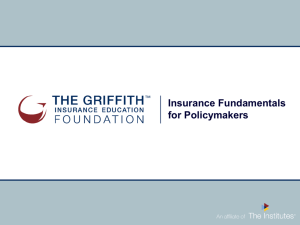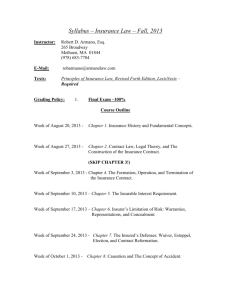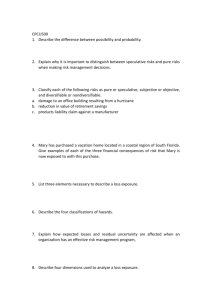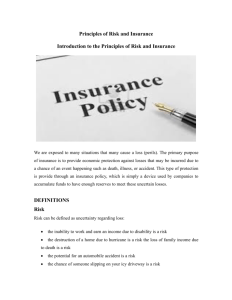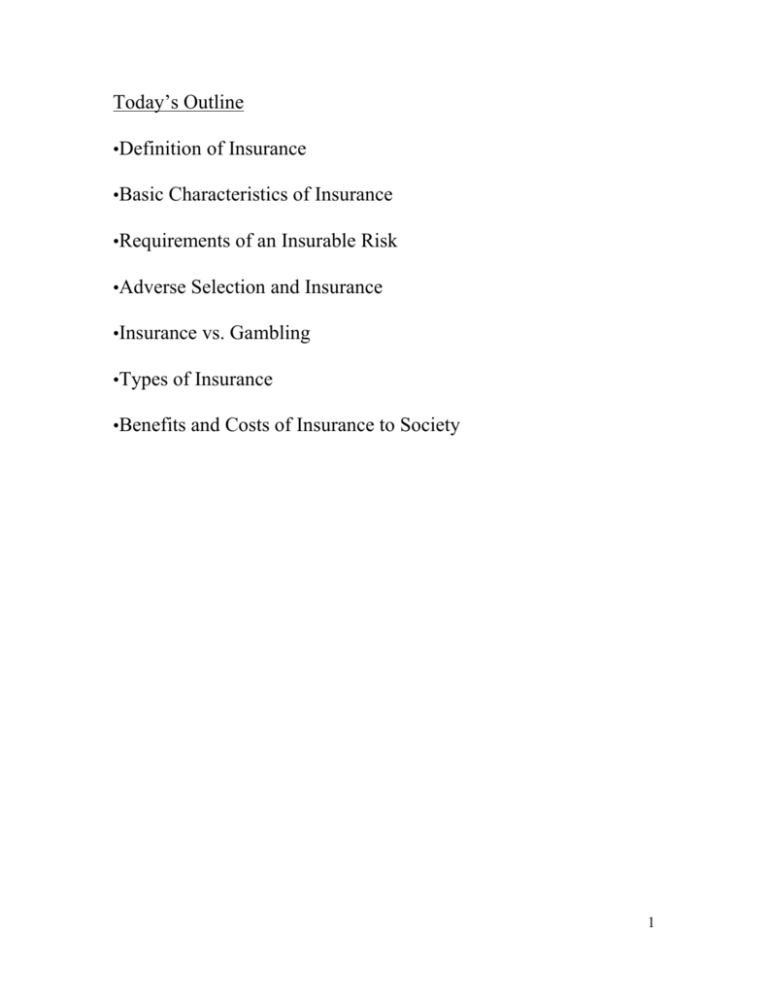
Today’s Outline
•Definition of Insurance
•Basic Characteristics of Insurance
•Requirements of an Insurable Risk
•Adverse Selection and Insurance
•Insurance vs. Gambling
•Types of Insurance
•Benefits and Costs of Insurance to Society
1
Basic Characteristics of Insurance
1. Pooling of losses
–Spreading losses incurred by the few over the entire group
Risk reduction based on grouping of a large number of
similar exposure units
–
Note: exposure units do not have to be identical but
subject to the same peril (cause).
Note: the Law of Large Numbers →s an accurate prediction
of future losses.
In general, pooling → 1) entire group share loss
2) LLN → predict future loss
2. Payment of fortuitous losses
Insurance pays for losses that are unforeseen, unexpected, a
result of chance
–
3. Risk transfer
–A pure risk is transferred from the insured to the insurer,
who typically is in a stronger financial position
2
4. Indemnification- The insured is restored to his or her
approximate financial position prior to the occurrence of the loss
Ex:
• Insurance - the pooling of fortuitous losses by transfer of such
risks to insurers, who agree to indemnify insureds for such losses,
to provide other pecuniary benefits on their occurrence, or to
render services connected with the risk
- Premium –the payment made by insureds to insurer for policy.
- Insurer- gets insurance premium and agrees to idemnify insureds
in the event of loss
- insured – pays insurance premium and in return is indemnified
in the event of a loss.
- claim – a demand for payment made for a covered loss by an
insured on an insurer.
Note: Insurance systems operate because insureds are risk averse
and, are therefore, willing to pay an insurance premium.
3
Requirements of an Insurable Risk
1. Large number of roughly similar exposure units
Why is this important?
So that the LLN → predict average loss
Note: exposure units must be s.t. same perils.
- to compile data over time and accurately predict loss for
similar individuals.
2. Accidental and unintentional loss
a. to control moral hazard
Note: if intentional loss was paid → ↑ in premiums
And if insurance is expensive then few who need insurance
will buy it and insurer won’t have enough exposure units to
predict future losses (LLN).
b. to assure randomness (required by LLN)
3. Determinable and measurable loss
- must be able to definitely determine cause, time, place and
amount.
- to facilitate loss adjustment
•insurer must be able to determine if the loss is covered and if
so, how much should be paid.
Ex:
4
4. No catastrophic loss
– to allow the pooling technique to work
Note: catastrophes overwhelm the pooling system
Ex:
–
exposures to catastrophic loss can be managed by:
- dispersing coverage over a large geographic area
- using reinsurance – initial insurer writes an insurance
transfer to another insurer for part or all of potential
losses.
- catastrophe bonds – creating financial instruments to
deal with catastrophic losses (securitization).
5. Calculable chance of loss
- must be able to accurately calculate:
1) average frequency of future losses
2) average severity of future losses
These 2 are necessary to establish an adequate premium
Note: Why FEMA offers flood insurance to individuals living in a
flood plain.
States provide unemployment insurance.
These circumstances do not fit this basic requirement for an
insurable risk. Therefore, private insurers are not willing to insure.
5
6. Economically feasible premium
–so
people can afford to buy
Premium must be substantially less than the face value of the
policy
–
Ex:
•When these Six requirements are met:
Most personal, property and liability risks can be insured
by private insurance
Note: Losses that are a result of market risks, financial risks,
production risks and political risks are difficult to insure
6
Exhibit 2.1 Risk of Fire as an
Insurable Risk
Copyright © 2008 Pearson Addison-Wesley. All rights reserved.
2-8
7
Exhibit 2.2 Risk of Unemployment
as an Insurable Risk
Copyright © 2008 Pearson Addison-Wesley. All rights reserved.
2-9
8
What are underwriters and why do we need them?
Adverse Selection and Insurance
•Adverse selection - the tendency of persons with a higher-than-
average chance of loss to seek insurance at standard rates
- If not controlled, adverse selection results in higherthan-expected loss levels
Ex: 2 groups purchasing health insurance: skateboarders (S)
and bookworms (B). Equal number of S &B, each lose $1000
in an accident and the probability of an accident is .1 and .2
for B & S, respectively. The cost of premiums for members
of B & S equals $0 .15 per dollar of coverage (.15 times the
amount of coverage). For now, ignore tvm and
administrative costs.
- If each B & S purchase $500 and $1000 worth of
coverage, respectively. Find the insurer’s revenues from
premiums for each policy holder:
9
What is the expected claim cost per policyholder?
Note: If insurer offers insurance to a heterogeneous group
→ skateboarders purchase a lot of insurance &
bookworms purchase very little insurance
Why?
consumers have full information and insurers don’t.
→ skateboarders know that they are daredevils.
→ bookworms know they are less likely to experience
injuries.
10
Adverse selection can be controlled by:
1) careful underwriting --The process of selecting
policyholders by recognizing and evaluating hazards,
establishing prices, and determining policy terms and
conditions
- underwriters can work in branch or regional
offices (line underwriters) or at corporate home
offices (staff underwriters)
2) policy provisions
Ex:
11
Back to skateboarder bookworm example with more careful
underwriting: Underwriter realizes that the amount of coverage for
S is greater than for B ($1000 in coverage vs $500) and has insurer
charge $.18 per dollar of coverage? At this rate, B will purchase
even less coverage. If Bs purchase $250 of coverage and S
continue to purchase $1000 then
- the insurer’s revenues from premiums for each policy
holder:
What is the expected claim cost per policyholder?
12
Insurance vs. Gambling
Insurance
Gambling
• Insurance is a technique
for handing an already
existing pure risk
• Gambling creates a new
speculative risk
• Insurance is socially
productive:
• Gambling is not socially
productive
– both parties have a common
interest in the prevention of
a loss
Copyright © 2008 Pearson Addison-Wesley. All rights reserved.
– The winner’s gain comes
at the expense of the loser
2-11
13
2 Types of Insurance
1) Private Insurance (in general, meets requirements of an
insurable risk)
- Life and Health
- Property and Liability
2) Government Insurance (in general, does not meet requirements
of an insurable risk)
- Social Insurance
- Other Government Insurance
14
Private Insurance
•
Life and Health
–Life insurance pays death benefits to beneficiaries when the
insured dies
Health insurance covers medical expenses because of
sickness or injury
–
–
•
Disability plans pay income benefits
Property and Liability
– Property insurance indemnifies property owners against the
loss or damage of real or personal property
Liability insurance covers the insured’s legal liability arising
out of property damage or bodily injury to others
–
Casualty insurance refers to insurance that covers whatever
is not covered by fire, marine, and life insurance
–
•Private insurance coverages can be grouped into two major
categories
–Personal lines - coverages that insure the real estate and
personal property of individuals and families or provide
protection against legal liability
–Commercial
lines -coverages for business firms, nonprofit
organizations, and government agencies
15
Government Insurance
•Social Insurance Programs
–Financed
entirely or in large part by contributions from
employers and/or employees
–Benefits
are heavily weighted in favor of low-income
groups
–Eligibility
and benefits are prescribed by statute
–Ex:
Social Security, Unemployment, Workers
Comp
•Other Government Insurance Programs
–Found
at both the federal and state level
–Ex: Federal flood insurance, state health
insurance pools
16
Social Costs and Benefits of Insurance
Social Benefits of Insurance
•Indemnification
for Loss
–Contributes to family and business stability
–
→ a better ability to plan for the future since fires,
death of family breadwinner or key employees cannot
ruin adequately insured families and businesses.
•Reduction
of Worry and Fear
–Insureds are less worried about losses
•Source
of Investment Funds
–Premiums may be invested, promoting economic
growth
•Loss
Prevention
–Insurers support loss-prevention activities that reduce
direct and indirect losses
•Enhancement
of Credit
–Insured individuals are better credit risks than
individuals without insurance
Ex:
17
Social Costs of Insurance
•Cost of Doing Business
–Insurers
consume resources in providing insurance to
society. Costs of resources used (labor, land, and
capital).
Note: nothing is produced, insuring what we have.
–An
expense loading is the amount needed to pay all
expenses, including commissions, general
administrative expenses, state premium taxes,
acquisition expenses, and an allowance for
contingencies and profit
•Fraudulent and Inflated Claims
–Payment
of fraudulent or inflated claims results in
higher premiums to all insureds, thus reducing
disposable income and consumption of other goods and
services
18
Who really pays for insured losses?
Ex: arson – the deliberate, malicious burning of a building or
other property.
Arson-for-profit - burning property to collect insurance
proceeds to defraud an insurer.
Note: the cost of arson is borne by everybody through the loss
sharing properties of the insurance mechanism (pooling), and
is not likely to be ultimately borne by the insurance company.
Also note: Insurance companies can't be substituted for police and
fire department investigators.
- generally won’t deny claims unless police and fire
departments provide evidence of fraud.
- But, insurance companies frequently work with law
enforcement officials to combat and convict fraudulent
claims
19



